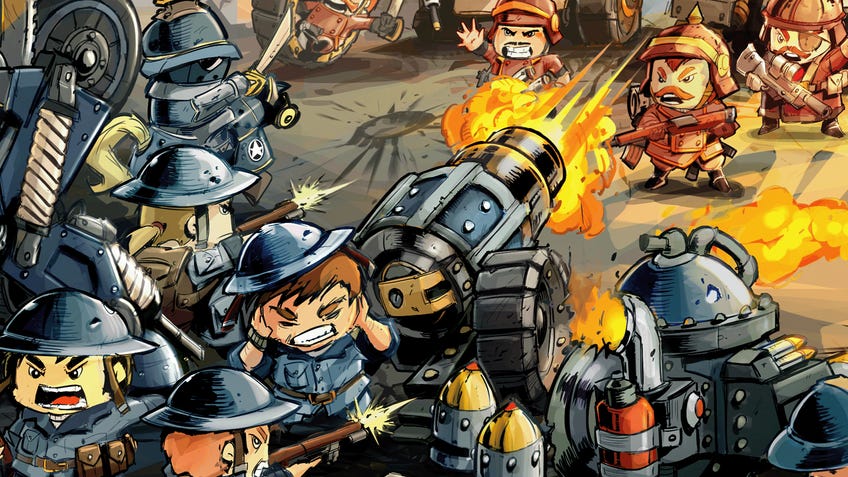Rivet Wars: Reloaded is like an Advance Wars board game - here's how it plays
RTS and video game influences meet a dieselpunk World War I.
World War I may not seem the most obvious next stop for Steamforged Games. The Manchester studio has made its name off the back of adapting various hit video games for the tabletop, from Dark Souls and Resident Evil to Monster Hunter and Horizon. Away from big-name franchises, the publisher has explored its own fantasy worlds in Guild Ball, Bardsung and Godtear. Delving into real history feels an unexpected leap from zombies, football and magical dogs.
Yet Rivet Wars: Reloaded isn’t just another World War I game. Its original setting mashes together historical influences from the era - without delving too deeply into the real-life horrors or problematic central figures involved - with dieselpunk mechs and vehicles reminiscent of artist Jakub Różalski’s 1920+ universe, as seen in board game Scythe, or Nintendo’s beloved tactical video game series Advance Wars.
The similarities are more than a passing resemblance. Rivet Wars’ gameplay is deeply rooted in video games influences, combining the territory control and unit management of real-time strategy games popularised by StarCraft, Command & Conquer and Age of Empires with the chibi-like visuals of mobile games like Clash of Clans.
It’s perhaps unsurprising: video game developer and artist Ted Terranova drew from his work on real-time strategy game Rise of Nations and the Definitive Edition remaster of Age of Empires III while creating the original 2014 game, while the team handling its latest Reloaded incarnation openly cite classic real-time strategy games such as Warcraft 3 as influences.
In other words, Rivet Wars still looks to be comfortable territory for Steamforged, which picked up the game earlier this summer before unveiling its impending return.
That return is a fully-fledged reboot in the form of Rivet Wars: Reloaded, which looks to spruce up the game’s visuals, miniatures and rules while staying true to Terranova’s world and gameplay. Ahead of a Kickstarter campaign on September 6th, lead designer Jamie Perkins and game designer Steve Margetson took us through a gameplay demo on Tabletop Simulator.
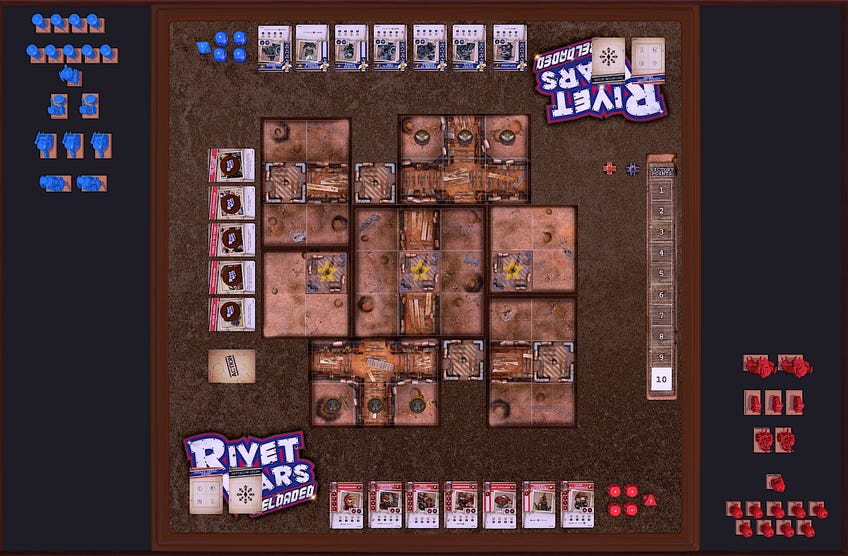
In the session, we took control of the opposed Allies and Blight forces, based on the Allied and Central Powers of WWI - albeit with added mechs and rocket cycles. Perkins acknowledged the sensitivity of releasing a war-themed game against the backdrop of the ongoing Russian invasion of Ukraine, confirming that Ruska and Ottoman factions - inspired by First World War Russian and Turkish troops - released as print-and-play expansions to the original game, would not be included as part of the new game’s first wave of boxes. The game’s tone as a whole has been shifted towards a less graphic depiction of war in its artwork.
Rivet Wars combines the territory control and unit management of real-time strategy games popularised by StarCraft, Command & Conquer and Age of Empires with the chibi-like visuals of mobile games like Clash of Clans.
Unlike the likes of Warhammer and other traditional miniature wargames, there’s no lengthy setup phase in Rivet Wars. The board begins the game empty, before players spend deployment points at the start of each turn to spawn new units, cashing in rivet tokens to summon more powerful units, including unique characters, artillery and vehicles. Action cards drawn at the start of each turn provide one-off effects, such as extra deployment points or additional movement.
Units vary from standard infantry and cannons to doomwheel-like bikes and Metal Gear-esque walking tanks. As well as having a starting loadout, bigger vehicles can be customised further by ‘plugs’ - pilots, weapons and other attachments that literally plug into vehicle miniatures to boost their firepower and abilities.
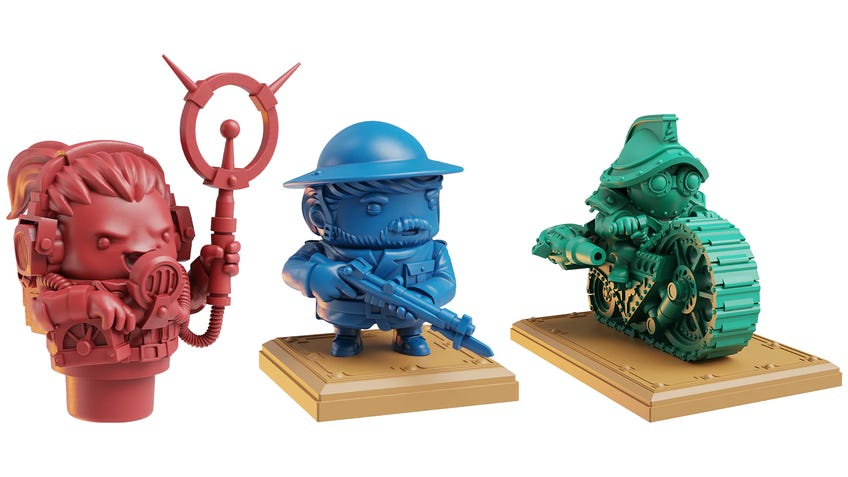
Units attack, before moving between squares on each gridded map tile - a single diagonal move is permitted during attack range and movement. Attacks are simple dice rolls, with the number of dice determined by the defence value of the unit they’re attacking; artillery may roll multiple dice against tougher opponents, while infantry peashooters won’t scratch armour. There’s no complicated attack versus defence maths or minutes-long calculation required; you either hit (on a 5 or 6) and deal a point of damage, or you don’t.
Things are kept basic, but not bland. Units are made distinct by their combination of movement speed, range - both against ground units and aerial attackers from planned expansions - and abilities helpfully recapped on the back of each card. (A noted quality-of-life improvement from the rulebook-searching jargon of the previous edition.) Foot soldiers gain extra movement by starting their turn in a trench, a sniper hero might grant bonus range to other units in their square, tanks have the chance to crush infantry by moving into their square, explosive rounds can result in splash damage within a square, and so on.
Defeating enemies can be a means to an end, but out-and-out bloodshed isn’t as important as claiming territory. Victory comes via holding strategic points such as bunkers on the board, gaining a point for each point held at the end of your turn. Points can be held remotely by planting a flag with infantry units, ticking up your score until an opponent seizes it back.
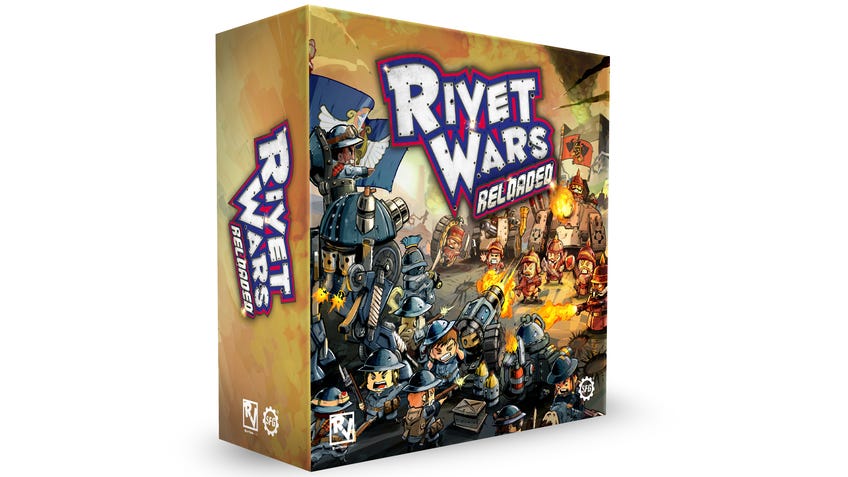
The territorial wrestle of scenarios brings to mind the objective-based battles of Warhammer 40,000 PC gem Dawn of War - while a few valuable units provide VP when defeated, mowing down cannon fodder typically won’t get you as far as sitting tight with a few well-placed units. Holding on to strategic points was made tricker in the demo scenario we played due to the trailing player’s option to flip the tiles over each turn, keeping the objectives moving to deter the leader parking on a valuable spot. (Sorry, campers.)
Things are kept basic, but not bland.
New to Reloaded are a set of mission cards designed to shake up the previously one-note grind toward ten victory points by holding objectives. One new mission unlocks each turn, with the first player to complete three of the available five claiming an instant victory. Goals range from defeating three units in a single turn and having units on five separate tiles to optionally completing a card instead of claiming points from two strategic points in a turn.
Rivet Wars’ core box will come with eight scenarios in the rulebook. Six of those form a connected campaign, which can be tackled as competitive battles or in new single-player and co-op modes, utilising an AI deck developed for Reloaded. The game-controlled opponent uses a combination of generic actions and trait cards specific to each faction that aim to capture the character of each army. The outcome of previous battles will influence later missions, with the losing side gaining helpful cards to keep things balanced.
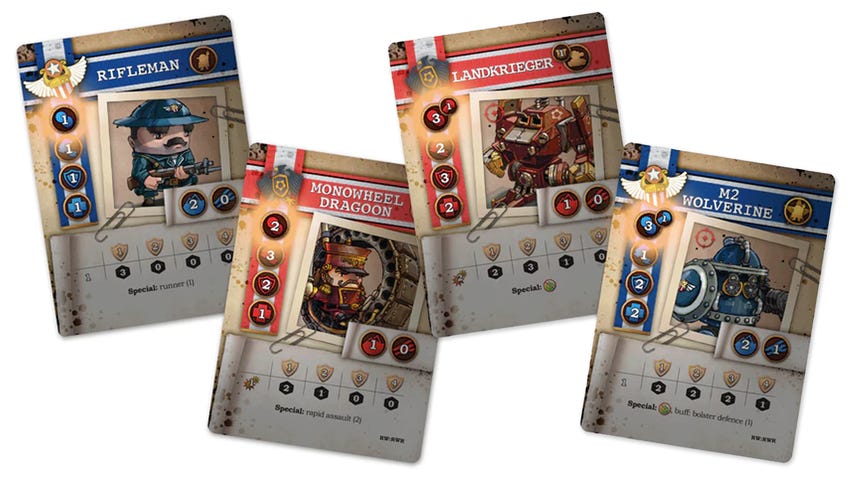
Dedicated players who exhaust the box’s content will be able to create their own custom scenarios. Reloaded adds new shapes and sizes of map tile to the original game’s standardised three-by-three squares, allowing for more dynamic layouts - such as one-square bottlenecks between larger tiles - and variations on its objective-based battles. One such mode recalls the Rush mode of first-person shooter video game Battlefield, with players pushing up the map, spawning new map tiles and removing claimed tiles as they gain territory. Another brings to mind the exploration of dungeon-crawling games or single-player RTS campaigns, with one player gradually revealing the forces of their opponent as they uncover new sections of the map.
In addition to the historically-grounded Allies and Blight factions in the core set, Steamforged has announced a third faction that leans further into the setting’s more fantastical elements: the Nemoans, a ‘decopunk’ army of subterranean dwellers inspired by the works of Journey to the Centre of the Earth author Jules Verne.
Rivet Wars: Reloaded is due to release in early 2024. The upcoming relaunch is designed to be backwards-compatible with previous releases for the original Rivet Wars, with a planned upgrade kit able to bring existing collections in line with the revamped ruleset.
